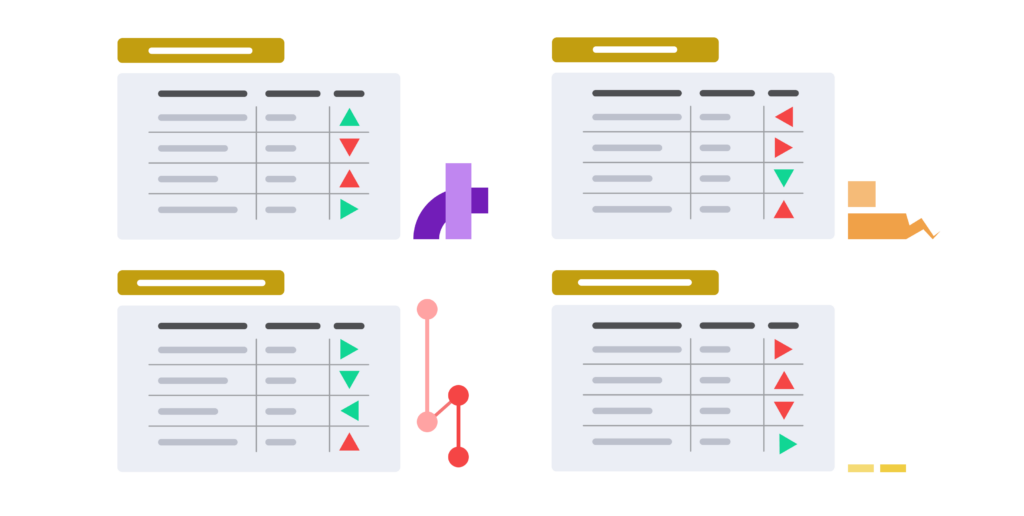Beyond the Bottom Line: Cost Savings & Other Misleading Metrics
As a procurement professional, you know how important it is to save those dollars. But cost saving isn’t as straightforward as it seems. And there’s a serious disconnect between procurement and finance teams when defining savings.
We recently caught up with Larry Wood, a longtime procurement leader and partner at The Simms Group, and Conrad Smith, CEO of Graphite Connect, to unravel the complexities of cost savings and other misleading procurement performance metrics.
Why Cost Savings Is Misleading

Cost savings means different things to different teams. Generally, the Chief Financial Officer (CFO) and finance team think about spend and run rates—the actual dollar impact on a company’s cash flow. Procurement, on the other hand, often sees savings as a measure of value added to the deal.
So, who’s right? Both are, in a sense. But to understand each perspective, let’s first define a few terms.
What Are Cost Savings, Cost Avoidance, and Cost Reduction?
In procurement, these two concepts are distinct yet related. Cost savings refer to actual reductions in current spending, which are tangible and visible in financial statements. For example, if a procurement team reduces material costs from $100,000 to $90,000, this is a clear cost saving of $10,000.
In contrast, procurement cost avoidance focuses on lowering costs and preventing future costs. It’s about avoiding potential increases in expenses, like maintaining a material’s price despite a market rise. This strategy doesn’t lower current expenses but prevents future ones from escalating.
While procurement teams often consider cost savings as value addition, finance teams see them as direct expense reductions. Understanding the difference between these and cost avoidance – which is less visible in financial reports but crucial for preventing future expenses – is key to aligning the perspectives of procurement and finance departments. Both approaches are essential for procurement performance in terms of financial efficiency and effectiveness.
What about cost reduction? Where does that fit into the discussion?
Cost reduction is an integral part of cost savings, focusing on decreasing current spending. It’s a proactive approach in procurement to reduce the actual amount of money being spent. Unlike cost avoidance, which is about dodging potential future expenses, cost reductions are about actively cutting down on present expenditures to save money.
Where’s the Wheelbarrow Full of Cash?
Conrad cites an example from his past experience where his predecessor in procurement had set a massive savings target. While they achieved it together, Conrad sensed a bit of exhaustion among the stakeholders, even finance. They questioned the credibility of the reported savings. So, he decided to take a different approach. He stopped reporting savings altogether.
When the CFO asked about this change more than two years later, it generated a 12-month discussion where it became clear that the two teams’ definitions of cost saving were vastly different. “To the CFO, when our team saved money, it was like he expected us to bring in a wheelbarrow of cash,” said Conrad. “In reality, the money had already been taken away during budgeting.”
At the beginning of the budget cycle, someone would ask for $10 million to run their department. Instead, they were given $8.5 million to run it. They’d be wringing their hands, wondering how they’d get by on the reduced budget. That’s when the procurement team would jump in and help them run their department and team on the allotted $8.5 million.
When procurement reported savings of $1.5 million, the CFO wanted that money back. But here’s the catch: although technically, there was $1.5 million in savings, you can’t get that money back because it’s already been allocated elsewhere.
This is the reason some organizations hesitate to celebrate these savings openly. If they do, the budget for the next year might be reduced by that same amount. Fear of drawing attention to cost savings since it might affect the future budget adds another layer of complexity.
It felt like a strange shell game determining what’s real cash that can be redeployed versus value-add, says Conrad. “As a procurement leader, I want to measure myself and my team on where we’re really adding value to the company. So, I would look at metrics generally different from how the finance CFO would look at it.”
Silly Metrics Lead to Silly Behaviors

The metrics you choose are critical because they could potentially have several unintended consequences in how they drive behavior—at a leadership level, at a stakeholder level, and inside the team. For example, focusing solely on key performance indicators such as cost savings can lead to negative behaviors while overlooking other important areas like quality, innovation, and supplier relationships. That’s why it’s so important to be thoughtful about the metrics you select and gain consensus on what the business should prioritize.
Part of the challenge is that too much emphasis is placed on rewarding people based solely on savings. This can lead to individuals inflating and manipulating forecasts, essentially sacrificing integrity and teamwork for the sake of looking successful. A balanced scorecard that considers multiple aspects of an efficient procurement process in addition to procurement key performance indicators is crucial to avoid unethical practices and ensure that the metrics add real value to the business.
Find the right balance
Striking a balance in the metrics and procurement KPIs you set is vital. This ensures that the chosen measures have the intended consequences and positively impact the business instead of leading to potentially risky and harmful outcomes.
The focus should be on selecting balanced metrics that encourage integrity, teamwork, and overall business success. By avoiding excessive emphasis on singular metrics and instead striving for a holistic approach, your procurement team can drive positive change and add genuine value to your organization.
Procurement as the air traffic controller
You play a unique role as your organization’s “air traffic controller” since procurement “sees” everything happening across different departments. This unique perspective allows your team to combine all the pieces and make informed decisions that benefit your entire organization.
Risk Management: How Do You Measure What Doesn’t Happen?

Risk management, an often misunderstood metric in procurement, is a form of cost avoidance. Effective risk management ensures timely delivery of essential components and uninterrupted production and is key in averting future costs associated with supply chain disruptions and security breaches. Though challenging to quantify, its value lies in the ability to see supply risks and prevent potential financial losses before they occur.
Although integral to supply chain operations for as long as the factory has existed, for too many suppliers and procurement professionals, risk management is the ‘elephant in the room’ that’s often overlooked or misunderstood.
“Ten years ago, there was absolute denial about the responsibility of procurement to do something with risk management because it was the worst hot potato in the enterprise,” says Conrad. “Nobody wanted to be responsible for why the security and privacy reviews took two months to get done.”
But the operational and stakeholder impact of risk management has become undeniable. Forward-thinking procurement organizations realize their crucial role in owning and managing these risks.
Larry agrees, “Risk management is a big layer of responsibility put on procurement. It’s a ticket to the dance, and you have to do it now.” But putting a metric on risk management remains elusive because when done well, nothing happens – a paradox that further complicates the ability to measure it.
It’s akin to the dilemma of saving money in a category that doesn’t yield visible, traditional savings. Risk management absorbs substantial time and effort, but its intangible nature makes it difficult to quantify and showcase as a value metric.
Yet, its significance can’t be ignored. A comprehensive risk-management process can prevent significant disruptions and losses, safeguarding your organization’s reputation and creating further stability.
ESG: Measuring Sustainability and Ethical Impact

The rise of ESG and corporate social responsibility adds a new layer of accountability for procurement professionals. Procurement is now pivotal in driving the company’s success and enhancing its public image. Yet, metrics around supplier performance and ESG can be slippery to manage.
“I see many cases where the CFO or CEO or somebody in the company makes a public statement about how they’re going to be carbon-neutral and not completely understanding that the lion’s share of their carbon footprint is happening in their supply base,” Conrad points out. “All of a sudden, purchasing has to figure out how they deal with carbon in their supply base. All this while under the expectation to do more with less.”
If procurement leaders are primarily rewarded based on cost savings, buy-in to these critical initiatives can be distorted, potentially hindering progress on vital sustainability and social impact efforts.
While production costs and savings remain important, a balanced approach to recognize and reward procurement’s efforts in contributing to sustainable and socially responsible practices is crucial. This alignment will enhance your company’s public image and drive positive impacts on the environment and within your community.
Align Metrics for Business Success

Your metrics and procurement key performance indicators should reflect your company’s broader business objectives, not just traditional cost-saving measures. So, as a procurement professional, how do you ensure that your metrics and overall procurement process align with your organization’s broader goals?
Get finance involved
First and foremost, get finance involved to define the metrics for savings. Collaborate with them to understand which metrics are vital to the business and align with their objectives. This partnership between finance and your procurement department will create a shared understanding of how your team’s efforts contribute to the overall financial success of the organization.
Ask questions and listen
Larry advises rather than telling stakeholders how things should be done, fostering open communication through inquiry. Ask questions and listen to the needs and expectations of the various departments within your company. Balancing your expertise with curiosity will help you to establish metrics even amidst diverse perspectives and needs.
Recognize there are two sides
An essential aspect of the metric alignment challenge is understanding the two different sides of metrics. On the one hand, you have finance and accounting goals to understand and report. On the other hand, you need to demonstrate your team’s value-add to the business. Bridging this gap requires getting the CFO and finance team to recognize the hard work and actual value that procurement brings to the table.
Conrad points out that there should be two reports. One is for finance, focusing on savings and financial objectives, and the other is tailored to the value-added contributions of the procurement department. By recognizing that these reports may not always match perfectly, you can show the diversity of your team’s impact.
Understand what drives department success
Purchasing metrics should equal the business metrics that matter to each department. You can align your efforts with their core objectives by understanding the unique performance indicators that spell success for your various business units.
For example, say you’re working with marketing, and the key focus is lead flow. How do you align that with your own procurement metrics to demonstrate value?
First, you’ll look at your suppliers and assess which ones significantly influence lead flow. Are there new technologies or suppliers that can enhance lead generation?
Lead flow will be a major driver in your selection and decision process, outweighing the sole focus on cost. Keep in mind that sometimes going with option B, even if it’s 20% more expensive, could result in double the leads, making it a no-brainer to invest in.
Leverage category plans and business reviews
Striking the right balance between company costs and outcomes will lead to business success. Procurement can find that crucial equilibrium by building yearly category plans and conducting quarterly business reviews.
For example, imagine a manufacturing company that’s launching eco-friendly products. Your procurement team crafts a yearly plan focused on sustainable packaging. You then work with the business unit to find eco-friendly suppliers, adjust metrics to include environmental impact, and ensure packaging aligns with the unit’s goals. This partnership leads to eco-conscious and cost-effective packaging, contributing to the unit’s success.
A quarterly business review will then help you evaluate how well the procurement strategy outlined in your category plan aligns with your business strategy and objectives. For instance, in the case of the manufacturing company above, a review would assess whether the eco-friendly packaging strategies yielded the desired outcomes. Did they help the environment and save costs? This ongoing review and adjustment ensures you keep the right balance between being eco-conscious and cost-effective.
By aligning metrics with the unique goals of each department, you can work hand in hand, ensuring your choices and investments drive success for the entire organization.
Think outside the box
Sometimes, innovation and value emerge from thinking beyond traditional procurement approaches. Beyond simple negotiations for better prices and cost-cutting, your true impact lies in driving innovation and uncovering hidden opportunities.
Is your team merely executing routine procurement processes, or are you proactively seeing opportunities for growth and improvement? Your value lies in enabling the company to thrive as a cost-cutting entity and a strategic partner.
“I would try to figure out ‘what is the value that procurement departments are delivering?’ Because if we’re not bringing true value and helping the business be more successful, we’re just friction and slowing it down,” says Conrad.
Ready to Learn More?
Explore how Graphite can help you collaborate more effectively with your partners and suppliers to create meaningful metrics that achieve shared objectives and drive business value.
Request a Demo